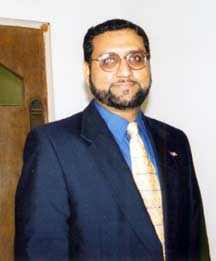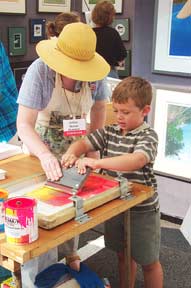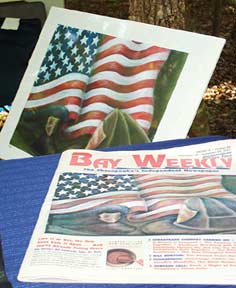|
|
 Calvert’s Mosque Opens Its Gates; Hundreds Stream In Calvert’s Mosque Opens Its Gates; Hundreds Stream In
photos by Bill Lambrecht
Southern Maryland Muslims like Mohammad Bilal Yousaf, left, invited people of all faiths to an interfaith prayer service at their mosque in Prince Frederick.
Until September 22, Prince Frederick’s Southern Maryland Islamic Center had never seen so many people. Traffic backed up from Route 2/4 into the mosque, and young men packed in cars as tightly and neatly as sardines. A house of worship used to a congregation of some 70 families stretched three or four times beyond its usual capacity.
Never before had so many Southern Marylanders seen the Islamic Center. Its tower and dome, so startling at first sight among the churches, tobacco fields and strip malls of Calvert County, have grown familiar in 15 years. But who — unless you’re Muslim — knew what might be inside?
 Especially after September 11, when Islamic extremists attacked America. Especially after September 11, when Islamic extremists attacked America.
In America, where so many cultures make a new world, we get to know one another’s culture at festival distance. How many of us have crossed the dividing line to visit a house where another culture rules — let alone the house of worship?
Yet last Saturday, illumined by the crescent moon that symbolizes Islam, the Southern Maryland Islamic Center threw open its decorative iron gates. Inside streamed a multicultural parade.
It opened its social hall. Filling chairs and aisles, hundreds snacked on pizza and, willingly if a bit tentatively, rubbed elbows.
It opened even its sanctuary. Here distinctions are so strictly observed that shoes are removed and women pray apart from men, screened from their sight and out of sight of imam. Yet tonight outsiders — Muslim, Christian, Jew, Buddhist, Hindu, Baha’i — thronged in among Muslims to hear the sunset prayer, the Magrib.
“You are welcome,” greeters — men sharply dressed in suits — told each of the guests, men and women alike.
One of them, Mohammad Bilal Yousaf, of Hughesville, explained that the diversity was no accident. The service had been organized jointly by leaders of each of the six faiths to offer prayers in honor of the victims in New York and at the Pentagon.
“We cannot let these perpetrators who conducted these heinous crimes against humanity hold this religion hostage. We do not stand for that. We reject, condemn and do not tolerate them,” Yousaf said.
Born in Pakistan, Yousaf followed his parents and brothers to America. The brothers, all U.S. citizens, now operate a defense contracting firm out of Waldorf. They are part of a multinational Islamic community that has formed around Dr. Issam Damalouji, who came to Southern Maryland in 1960 to join the staff of what is now Calvert Memorial Medical Center.
“We love being here and we find this the best country on the face of the earth, with freedom — and open to all regardless of caste, color, creed — to live peacefully in harmony,” Yousaf said, of his family and his community.
“It is our failure we had not opened our doors, not talked enough to explain who we are and what we stand for,” he said.
His hopes for new openness were duplicated throughout the crowded mosque. One who shared them was former Sen. Bernie Fowler, who, as an administrator at the hospital, has 40-year ties with many of the doctors who are the core of Calvert’s Muslim community.
“This is a time to come together as Americans,” Fowler said, “and I felt that my presence here would show that solidarity of spirit in Southern Maryland.”
— SOM
 Flying Your Flag ~ the Right Way Flying Your Flag ~ the Right Way
Year after year, we don our patriotic spirit for a few short holidays out of the year: Memorial Day, the Fourth of July and Labor Day, and out come our grand old flags. But since that fateful Tuesday morning in September 2001, we have worn a spirit of patriotism that we don’t dare remove.
Our intentions are good. We didn’t walk to get out our flags; we ran a relay race to our basements, attics, and garages. We drove to a maze of stores in search of flags they didn’t have.
Hooray for us. Hooray for the flag. But there’s an etiquette to handling Old Glory.
The U.S. flag is protected by Federal Law. Here’s a bit of what you need to know, excerpted from Section 176 of the U.S. Code, Respect for Flag:
- The American flag should be flown at half-staff (half-mast is reserved for ships and boats) when the entire nation is in mourning. From September 11 to 22, the flag was flown at half staff by our president’s order.
When the U.S. flag flies at half-staff, it should be first raised to the top of the flagpole for a moment and then lowered to the half-staff position. It is raised again before being lowered for the day. Other flags flying adjacent to Old Glory also must be flown at half-staff or taken down.
A black streamer should be attached to the top of the pole if the American flag cannot be displayed at half-staff. A black bow should be affixed to the fastening points of U.S. flags hung on walls or windows.
- Old Glory is normally flown from sunrise to sunset. It may be flown after dark if it is illuminated.
- If hung in inclement weather, the flag should be made of a weather-resistant material.
- It should never touch the ground.
- No flag should be placed above the U.S. flag or to its right at the same height. When surrounded by flags of states or localities, the American flag should be at the center and highest point of the group.
- When hanging horizontally or vertically against a wall, the blue field should be uppermost and to the flag’s right, the observer’s left.
- In a window, the blue should be to the left of the observer in the street.
— Nadine Word w/Mandy Yost, Scripps Howard Foundation Newswire
How to Save those Historic Headlines
The newspapers we’ve been devouring all week are the best record our children and grandchildren will have of the national tragedy of September 11 and its aftermath of heroism and grieving. We’re reading and rereading ours, in the process making them such a mess that they’re hardly worth saving. For that purpose, we bought second copies.
But newsprint ages quickly. If you want the papers you’ve saved to hold up to tell the story, follow these tips:
- Do not put the paper in a plastic bag for storage in an attic or basement, where it will decay.
- Lay the newspaper flat. Don’t store it folded along the middle. That fold is the first place a newspaper will decay and discolor.
- To prevent age toning and embrittlement, store in an acid-free paper folder available at most art and office stores.
- Keep paper away from extremes in temperature or humidity.
- If framing, use an acid-free matte and UV-3 Plexiglas, which protect paper from 96 percent of ultraviolet rays and prevent discoloring and fading.
 Art Gained on Nature Art Gained on Nature
photos by Rachel Presa
Kids found hands-on arts fun at this year’s Artsfest at Annmarie Gardens in Solomons.
Artsfest has a reputation to live up to.
The weekend event at Annmarie Garden in Solomons has been nine years making a name for itself.
Which means that each year must be better than the last.
In a region more known for sports than arts, Artsfest got top billing this weekend. A destination for throngs that reached far into the thousands, the outdoor festival drew artists, art lovers and nature lovers alike.
Almost 300 artists, working in nearly as many forms and mediums, gilded nature with art. Chosen by a jury of their peers, they gathered from as near as Lusby and as far as Florida to spread themselves across the 30-acre park.
Visual artists 165 strong spread their wares on tables and under tents, under shade and in the sun. Musicians, dancers and actors performed on paths and stages. Even the culinary arts were well represented by local vendors proffering treats from crab cakes to souvlaki.
Their work was appreciated. All weekend, Solomons teemed with aficionados by the thousands. Adults and children, toddlers and teens from as far off as Flagstaff, Arizona, came to look, to learn and to buy.
 Many bought. Huntingtown artist Chrissy Miller sold 82 of her 200 limited edition prints, “In Honor of Our Fallen Heroes,” which you saw on Bay Weekly’s cover last week, raising $8,200 so far for New York Firefighters and Police funds. Many are donating the prints to their fire or police department. [Order yours at 410/535-4412.] Many bought. Huntingtown artist Chrissy Miller sold 82 of her 200 limited edition prints, “In Honor of Our Fallen Heroes,” which you saw on Bay Weekly’s cover last week, raising $8,200 so far for New York Firefighters and Police funds. Many are donating the prints to their fire or police department. [Order yours at 410/535-4412.]
Woodworker Tom Yates, of Grasonville, sold three quarters of the anthropomorphic driftwood he brought. He says his sales improve with each year he comes to Artsfest.
Some artists found return customers.
“I must have been approached by at least 15 people who bought my work in years past,” says jewelry maker Cindy Blackburn, of Baltimore. “It was rewarding to see somebody with one of my rings or earrings on and get to talk to them again.”
Quite a few took home new art for their home or body. Just as many kids and grown-ups walked off with some art of their own after visiting the Discovery Tent, where they tried their hands at the techniques of the masters.
Learning and doing are big parts of Artsfest, says park director Jennifer Draxton.
“People can appreciate art better when they see how it is made,” she explains. Indeed, crowds seemed to spring up whenever a painter, potter or glassblower pulled out a brush, wheel or blowtorch.
“This event is purely about the arts, both man-made and nature-made,” Draxton says. “People are free to meander about and see everything at their own pace, instead of being forced down aisles or crammed in a room. It’s a relaxing and stimulating setting.”
Draxton has conducted Artsfest since it was little more than a sketch. Now the event is a masterpiece in itself, and Draxton proclaims herself “amazed” at how far it has come.
The artists that the festival attracts are of the same mind as Draxton when it comes to the success of this event.
“It’s the setting,” says Blackburn. “There isn’t really another event out there like this one. Usually the setting is not conducive to art; here, the setting enhances the art, and vice versa.”
Adds woodworker Yates: “The festival is a discovery process. All the arts are represented, and all the senses are touched in some way.”
“This is a true arts festival,” says Abigail Francisco of North Beach, whose ballet students performed in the wooded Council Ring, a granite amphitheater deep in the park.
“This event offers the community a place to accept the artist, and the artists a place to present themselves to the community,” says lapidary artist Chris McConnell, of Lusby, who brought his cut gemstones to Artsfest for the first time this year. “There’s more to this town than fishing and farming, and Artsfest proves it.”
— Rachel Pres
Way Downstream …
In Calvert County, the Nuclear Regulatory Commission last week reported a code-yellow safety violation by the Calvert Cliffs nuclear plant that was related to faulty maintenance of a critical pump. How serious was it? The color coding begins with green violations and continues to white, yellow and then red …
In Virginia, authorities noticed a web site with tantalizing photos of steamed crabs on platters. Only problem was that the Freshest.net cyber-seafood business didn’t have a commercial license to harvest crabs or health certification to handle and sell crab meat, the Virginia Marine Patrol charged last week …
Also in Virginia, the state legislature is considering a plan that conservationists find strange: It would grant amnesty for waterfront construction along Chesapeake Bay that violated a 1988 law intended to prevent such projects. It is a “compromise” aimed at modernizing the old law, which local governments often ignored. But the Chesapeake Bay Foundation and others say it would send the wrong message and trigger more unwise development …
Britain is where a pair of the world’s most endangered birds are temporarily residing, and Brazil wants them back. They’re bright blue Lear’s macaws, parrots that were confiscated three years ago from a smuggler who went to jail. To pressure the Brits, who seem to have grown fond of the birds, the Brazilian Environmental Institute is rallying support from activists …
Our Creature Feature comes from Hawaii, where tourists have complained so loudly about a tiny chirping frog that authorities have begun “eliminating” them in a curious way.
The frogs are called the coqui, possibly because the sound they make, usually at night, is something like “co-KEE, co-KEE.” As a result of complaints, pest-controllers are spraying them with vast amounts of caffeine that are equivalent to drinking 150 cans of, that’s right, Coke. Hawaiians don’t seem to mind giving frogs heart attacks, but half a world away, Puerto Ricans are upset at what they call “coquicide.” That’s because the coqui is a revered national symbol in Puerto Rico.
Copyright 2001
Bay Weekly
|